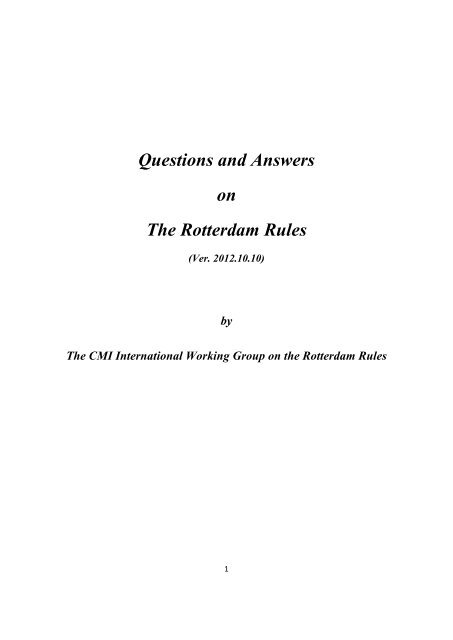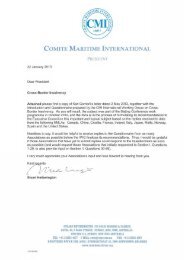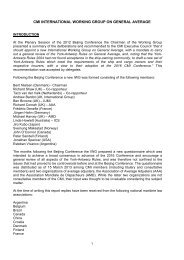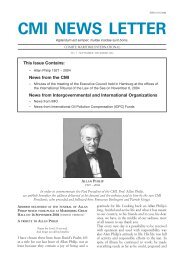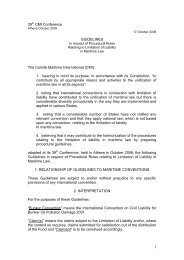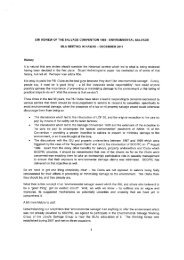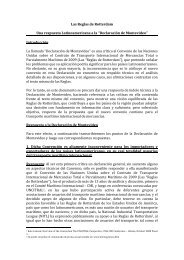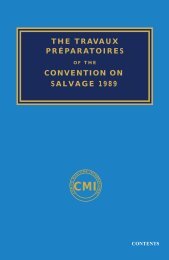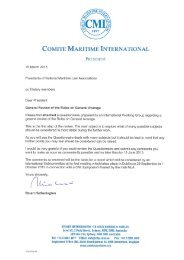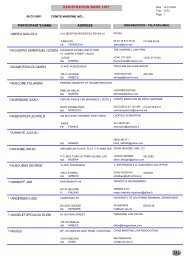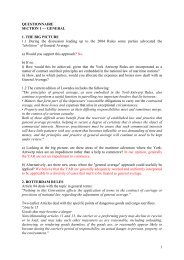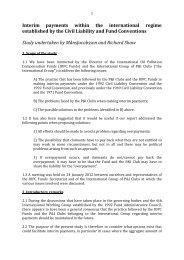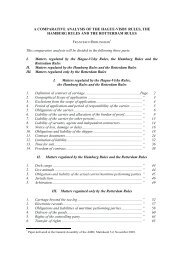Questions and Answers on The Rotterdam Rules - Comite Maritime ...
Questions and Answers on The Rotterdam Rules - Comite Maritime ...
Questions and Answers on The Rotterdam Rules - Comite Maritime ...
Create successful ePaper yourself
Turn your PDF publications into a flip-book with our unique Google optimized e-Paper software.
<str<strong>on</strong>g>Questi<strong>on</strong>s</str<strong>on</strong>g> <str<strong>on</strong>g>and</str<strong>on</strong>g> <str<strong>on</strong>g>Answers</str<strong>on</strong>g><strong>on</strong><strong>The</strong> <strong>Rotterdam</strong> <strong>Rules</strong>(Ver. 2012.10.10)by<strong>The</strong> CMI Internati<strong>on</strong>al Working Group <strong>on</strong> the <strong>Rotterdam</strong> <strong>Rules</strong>1
C<strong>on</strong>tentsC<strong>on</strong>tents ............................................................................................................................ 2Preface .............................................................................................................................. 3<str<strong>on</strong>g>Questi<strong>on</strong>s</str<strong>on</strong>g> <str<strong>on</strong>g>and</str<strong>on</strong>g> <str<strong>on</strong>g>Answers</str<strong>on</strong>g> <strong>on</strong> the <strong>Rotterdam</strong> <strong>Rules</strong>.............................................................. 5A. Scope of Applicati<strong>on</strong>, Pers<strong>on</strong>s Covered by the C<strong>on</strong>venti<strong>on</strong>, <str<strong>on</strong>g>and</str<strong>on</strong>g> the MultimodalAspect ............................................................................................................................... 5B. Carrier’s Obligati<strong>on</strong>s, Period of Resp<strong>on</strong>sibility <str<strong>on</strong>g>and</str<strong>on</strong>g> Liabilities ................................. 11C. Shipper’s Obligati<strong>on</strong>s <str<strong>on</strong>g>and</str<strong>on</strong>g> Liabilities ........................................................................ 18D. Transport Documents, Right of C<strong>on</strong>trol <str<strong>on</strong>g>and</str<strong>on</strong>g> Delivery of the Goods ......................... 20E. Jurisdicti<strong>on</strong> <str<strong>on</strong>g>and</str<strong>on</strong>g> Arbitrati<strong>on</strong> ....................................................................................... 21F. Volume C<strong>on</strong>tracts <str<strong>on</strong>g>and</str<strong>on</strong>g> Freedom of C<strong>on</strong>tract .............................................................. 22G. Others ......................................................................................................................... 252
PrefaceOn December 11, 2008, during its 63 rd sessi<strong>on</strong>, the UN General Assemblyadopted the “United Nati<strong>on</strong>s C<strong>on</strong>venti<strong>on</strong> <strong>on</strong> C<strong>on</strong>tracts for the Internati<strong>on</strong>al Carriage ofGoods Wholly or Partly by Sea (<strong>Rotterdam</strong> <strong>Rules</strong>).” <strong>The</strong> C<strong>on</strong>venti<strong>on</strong> became open forsignature at the signing cerem<strong>on</strong>y in <strong>Rotterdam</strong> <strong>on</strong> September 23, 2009.Comité <strong>Maritime</strong> Internati<strong>on</strong>al, which has been involved in the process ofdrafting the <strong>Rotterdam</strong> <strong>Rules</strong> from the early stages, endorsed the <strong>Rotterdam</strong> <strong>Rules</strong> (then“the Draft C<strong>on</strong>venti<strong>on</strong>”) at its 39 th C<strong>on</strong>ference in Athens. Taking into account thepractical <str<strong>on</strong>g>and</str<strong>on</strong>g> historical importance of the new regime for the internati<strong>on</strong>al carriage ofgoods, the Executive Council decided that the CMI would c<strong>on</strong>tinue to m<strong>on</strong>itor theadopti<strong>on</strong> <str<strong>on</strong>g>and</str<strong>on</strong>g> implementati<strong>on</strong> of <strong>Rotterdam</strong> <strong>Rules</strong>, <str<strong>on</strong>g>and</str<strong>on</strong>g> established an internati<strong>on</strong>alworking group <strong>on</strong> the <strong>Rotterdam</strong> <strong>Rules</strong> for this purpose.<strong>The</strong> <strong>Rotterdam</strong> <strong>Rules</strong> c<strong>on</strong>sist of 96 articles that were drafted carefully <str<strong>on</strong>g>and</str<strong>on</strong>g>deliberately. Because of their highly technical nature <str<strong>on</strong>g>and</str<strong>on</strong>g> their comprehensive coverageof the relevant issues, those who first read these rules might need some help to properlyunderst<str<strong>on</strong>g>and</str<strong>on</strong>g> as to how the <strong>Rules</strong> work <str<strong>on</strong>g>and</str<strong>on</strong>g> what they achieve.<strong>The</strong> Internati<strong>on</strong>al Working Group <strong>on</strong> the <strong>Rotterdam</strong> <strong>Rules</strong> thought it wouldbenefit all involved if it were to make a “<str<strong>on</strong>g>Questi<strong>on</strong>s</str<strong>on</strong>g> <str<strong>on</strong>g>and</str<strong>on</strong>g> <str<strong>on</strong>g>Answers</str<strong>on</strong>g>” list that coincideswith the Signing Cerem<strong>on</strong>y <str<strong>on</strong>g>and</str<strong>on</strong>g> clarifies comm<strong>on</strong>ly asked questi<strong>on</strong>s <str<strong>on</strong>g>and</str<strong>on</strong>g> correctsoccasi<strong>on</strong>al misunderst<str<strong>on</strong>g>and</str<strong>on</strong>g>ings that arise. It should be noted that the intent of these“Q&As” are not to evaluate the <strong>Rotterdam</strong> <strong>Rules</strong>’ pros <str<strong>on</strong>g>and</str<strong>on</strong>g> c<strong>on</strong>s, nor to persuadegovernments to ratify them. <strong>The</strong> sole purpose is to offer guidance for an easy <str<strong>on</strong>g>and</str<strong>on</strong>g>correct underst<str<strong>on</strong>g>and</str<strong>on</strong>g>ing of the <strong>Rules</strong>.We hope that the “Q&As” will help the readers of <strong>Rotterdam</strong> <strong>Rules</strong>.October 10, 2009Internati<strong>on</strong>al Working Group <strong>on</strong> the <strong>Rotterdam</strong> <strong>Rules</strong>3
Tomotaka FUJITA, Chairman (Japan)Jose' Tomas GUZMAN (Chile)Stuart BEARE (the U.K.)Gertjan VAN DER ZIEL (the Netherl<str<strong>on</strong>g>and</str<strong>on</strong>g>s)Philippe DELEBECQUE (France)Kofi MBIAH (Ghana)Hannu HONKA (Finl<str<strong>on</strong>g>and</str<strong>on</strong>g>)Barry OLAND (Canada)Revisi<strong>on</strong> HistoryOct. 10, 2009Several editorial correcti<strong>on</strong>s.Oct. 10, 2012 Two questi<strong>on</strong>s <str<strong>on</strong>g>and</str<strong>on</strong>g> answers were added in Part A (No.7 <str<strong>on</strong>g>and</str<strong>on</strong>g> 11).4
<str<strong>on</strong>g>Questi<strong>on</strong>s</str<strong>on</strong>g> <str<strong>on</strong>g>and</str<strong>on</strong>g> <str<strong>on</strong>g>Answers</str<strong>on</strong>g> <strong>on</strong> the <strong>Rotterdam</strong> <strong>Rules</strong>A. Scope of Applicati<strong>on</strong>, Pers<strong>on</strong>s Covered by the C<strong>on</strong>venti<strong>on</strong>, <str<strong>on</strong>g>and</str<strong>on</strong>g> theMultimodal Aspect1. Do the <strong>Rotterdam</strong> <strong>Rules</strong> apply to individual shipments under booking c<strong>on</strong>tracts ofslot charterers, space charterers in liner or n<strong>on</strong>-liner transportati<strong>on</strong>? Do the<strong>Rotterdam</strong> <strong>Rules</strong> apply to individual shipments under l<strong>on</strong>g term c<strong>on</strong>tracts withNVOCs?<strong>The</strong> applicati<strong>on</strong> of the <strong>Rules</strong> should be determined when specific c<strong>on</strong>tract terms arefilled in to the general c<strong>on</strong>diti<strong>on</strong>s.If individual shipments under booking c<strong>on</strong>tracts or l<strong>on</strong>g term c<strong>on</strong>tracts are performed ina n<strong>on</strong>-liner transportati<strong>on</strong>, the <strong>Rotterdam</strong> <strong>Rules</strong> do not apply either to the terms of thebooking c<strong>on</strong>tracts or the l<strong>on</strong>g term c<strong>on</strong>tracts or to the terms of individual shipments(article 6(2)) unless they do not qualify as “<strong>on</strong> dem<str<strong>on</strong>g>and</str<strong>on</strong>g> carriage” (article 6(2)(b)).If individual shipments are performed in a liner service <str<strong>on</strong>g>and</str<strong>on</strong>g> if they are not charterpartiesor other c<strong>on</strong>tracts for the use of a ship or of any space there<strong>on</strong>, the <strong>Rotterdam</strong> <strong>Rules</strong>apply to the terms of individual shipments <str<strong>on</strong>g>and</str<strong>on</strong>g> the terms c<strong>on</strong>tained in the bookingc<strong>on</strong>tracts, or l<strong>on</strong>g term c<strong>on</strong>tracts to the extent that they are applicable to the individualshipments.2. What is the intenti<strong>on</strong> of the proviso of article 6(2)? Does article 7 not also make the<strong>Rotterdam</strong> <strong>Rules</strong> apply when a transport document or an electr<strong>on</strong>ic transport recordis issued?<strong>The</strong> chapeau of article 6(2) excludes c<strong>on</strong>tracts of carriage in n<strong>on</strong>-liner transportati<strong>on</strong>.However, there is a case where the exclusi<strong>on</strong> of n<strong>on</strong>-liner transportati<strong>on</strong> also excludes atype of c<strong>on</strong>tract that has been covered by the Hague <str<strong>on</strong>g>and</str<strong>on</strong>g> the Hague-Visby <strong>Rules</strong>. Thistype of c<strong>on</strong>tract is sometimes called “<strong>on</strong> dem<str<strong>on</strong>g>and</str<strong>on</strong>g>” carriage, to which the proviso ofArticle 6(2) refers as follows: “When (a) there is no charterparty or other c<strong>on</strong>tract5
Article 12(3) explicitly allows the parties to agree <strong>on</strong> the time <str<strong>on</strong>g>and</str<strong>on</strong>g> locati<strong>on</strong> of the receipt<str<strong>on</strong>g>and</str<strong>on</strong>g> delivery of the goods. <strong>The</strong> <strong>on</strong>ly restricti<strong>on</strong> is the proviso in Article 12(3) that thetime of receipt of the goods cannot be after the beginning of their initial loading, <str<strong>on</strong>g>and</str<strong>on</strong>g> thetime of delivery of the goods cannot be before the completi<strong>on</strong> of their final unloading.<strong>The</strong>refore, it is perfectly possible for the parties, for instance, to enter into a traditi<strong>on</strong>al“port-to-port” c<strong>on</strong>tract of carriage in which the shipper delivers the goods to thec<strong>on</strong>tainer yard of the port of loading, <str<strong>on</strong>g>and</str<strong>on</strong>g> the carrier unloads them at the c<strong>on</strong>tainer yardof the port of discharge, with the carrier <strong>on</strong>ly resp<strong>on</strong>sible for the carriage between thetwo c<strong>on</strong>tainer yards.5. How do the <strong>Rotterdam</strong> <strong>Rules</strong> apply to total door-to-door transport? Do the <strong>Rules</strong>regulate the liability of the carrier who may not necessarily be resp<strong>on</strong>sible for acertain part of the transport?<strong>The</strong> <strong>Rotterdam</strong> <strong>Rules</strong> apply to “door to door transport” <strong>on</strong>ly if the parties agree that thecarrier assumes the resp<strong>on</strong>sibility for the whole part of the transport, including l<str<strong>on</strong>g>and</str<strong>on</strong>g> legs.Nothing in the <strong>Rotterdam</strong> <strong>Rules</strong> prevent parties from entering into a pure maritimec<strong>on</strong>tract (“port to port” or even “tackle to tackle”) <str<strong>on</strong>g>and</str<strong>on</strong>g> the <strong>on</strong>ly restricti<strong>on</strong> is article12(3). See, also Questi<strong>on</strong> 4.6. How are the possible c<strong>on</strong>flicts with other c<strong>on</strong>venti<strong>on</strong>s solved under the <strong>Rotterdam</strong><strong>Rules</strong>?Article 26, introducing the “limited network rule”, mostly removes the possible c<strong>on</strong>flictwith other C<strong>on</strong>venti<strong>on</strong>s, such as CMR or COTIF-CIM. Article 82 provides thesafeguard for a c<strong>on</strong>tracting state to other c<strong>on</strong>venti<strong>on</strong>s to the extent that such c<strong>on</strong>venti<strong>on</strong>sapply to the sea carriage.7. Article 26 provides that it applies “when loss of or damage to goods, or an event orcircumstance causing a delay in their delivery, occurs during the carrier’s period ofresp<strong>on</strong>sibility but solely before their loading <strong>on</strong>to the ship or solely after theirdischarge from the ship”. It appears that the phrase “an event or circumstancecausing” should apply not <strong>on</strong>ly to delay but also loss of or damage to goods. <strong>The</strong>current text of article 26 seems incorrect.7
13. Is it possible for the parties to give the pers<strong>on</strong>s who are not covered by article 4(1)the same defense <str<strong>on</strong>g>and</str<strong>on</strong>g> ex<strong>on</strong>erati<strong>on</strong> as the carrier via “Himalaya” clause? Does itc<strong>on</strong>stitute a “term in a c<strong>on</strong>tract of carriage” that “directly or indirectly excludes orlimits the obligati<strong>on</strong>s of the carrier” which is void pursuant to article 79(1)?Nothing in the <strong>Rotterdam</strong> <strong>Rules</strong> prevent the parties of the c<strong>on</strong>tract of carriage fromagreeing <strong>on</strong> a “Himalaya clause” for the benefit of n<strong>on</strong>-maritime performing parties orother pers<strong>on</strong>s who are not covered by article 4(1). <strong>The</strong> <strong>Rotterdam</strong> <strong>Rules</strong> leave the issueof liability of such pers<strong>on</strong>s including the validity of the “Himalaya clause” to nati<strong>on</strong>allaw <str<strong>on</strong>g>and</str<strong>on</strong>g> the issue is outside the scope of article 79.B. Carrier’s Obligati<strong>on</strong>s, Period of Resp<strong>on</strong>sibility <str<strong>on</strong>g>and</str<strong>on</strong>g> Liabilities1. Is it possible for the carrier to limit their period of resp<strong>on</strong>sibility by c<strong>on</strong>tract?First, the carrier cannot unilaterally limit the period of resp<strong>on</strong>sibility. This should beagreed in the c<strong>on</strong>tract of carriage. Sec<strong>on</strong>d, there is a restricti<strong>on</strong> for c<strong>on</strong>tractualagreement to avoid its misuse. A provisi<strong>on</strong> in a c<strong>on</strong>tract of carriage is void to the extentthat it provides that (a) the time of receipt of the goods is subsequent to the beginning oftheir initial loading under the c<strong>on</strong>tract of carriage or (b) the time of delivery of thegoods is prior to the completi<strong>on</strong> of their final unloading under the c<strong>on</strong>tract of carriage.(article 12(3))2. Article 12(3)(a) states that the time of receipt of the goods cannot be defined to beafter "their initial loading under the c<strong>on</strong>tract of carriage". What is "initial loadingunder the c<strong>on</strong>tract of carriage"? Can it mean "al<strong>on</strong>gside the vessel", i.e. tackle totackle, as in the current Hague-Visby <strong>Rules</strong>, because Article 12(3)(a) uses the term"initial loading", not "initial receipt"?“Initial loading under the c<strong>on</strong>tract of carriage” means loading <strong>on</strong> the first means oftransportati<strong>on</strong>, which could be a ship, a truck, a train, or even an aircraft. If the <strong>on</strong>lymeans of transport used in the c<strong>on</strong>tract of carriage in questi<strong>on</strong> is a ship, article 12(3), insubstance, means that the parties cannot agree <strong>on</strong> a c<strong>on</strong>tract of carriage with a period ofresp<strong>on</strong>sibility that is shorter than “tackle to tackle”.11
(i) Loading, h<str<strong>on</strong>g>and</str<strong>on</strong>g>ling, stowing, or unloading of the goods performed pursuantto an agreement in accordance with article 13, paragraph 2, unless the carrier or aperforming party performs such activity <strong>on</strong> behalf of the shipper, the documentaryshipper or the c<strong>on</strong>signee.” (Emphasis added).5. Article 11 provides that “the carrier shall, subject to this C<strong>on</strong>venti<strong>on</strong> <str<strong>on</strong>g>and</str<strong>on</strong>g> inaccordance with the terms of the c<strong>on</strong>tract of carriage, carry the goods to the place ofdestinati<strong>on</strong> <str<strong>on</strong>g>and</str<strong>on</strong>g> deliver them to the c<strong>on</strong>signee”. In additi<strong>on</strong> to terms set out in theC<strong>on</strong>venti<strong>on</strong>, is the carrier free to include other terms in the c<strong>on</strong>tract of carriage thatare outside the C<strong>on</strong>venti<strong>on</strong>? If so, what type of terms would possibly be included?<strong>The</strong> carrier <str<strong>on</strong>g>and</str<strong>on</strong>g> the shipper are free to incorporate any terms that are not restricted bythe <strong>Rotterdam</strong> <strong>Rules</strong>. <strong>The</strong> payment of freight, time of delivery, laytime <str<strong>on</strong>g>and</str<strong>on</strong>g> demurrage,or opti<strong>on</strong>s to change port of destinati<strong>on</strong> are examples of such terms. <strong>The</strong> parties can alsoinsert a liberty clause such as “Caspiana” or “war clause” which would permit thecarrier to discharge the goods at a different place than original destinati<strong>on</strong> under certainexcepti<strong>on</strong>al circumstances. <strong>The</strong>se clauses can be interpreted as providing an alternativedesitinati<strong>on</strong> which can be chosen under certain circumstances <str<strong>on</strong>g>and</str<strong>on</strong>g> should not beautomatically invalidated as derogati<strong>on</strong> from the carrier’s obligati<strong>on</strong> under article 11.6. Article 14 appears to replicate Article III(1) of the Hague-Visby <strong>Rules</strong>.(1) How does Article 14 relate to Article 17?(2) What is the c<strong>on</strong>sequence if due diligence is not exercised?(3) Who has the burden of proof of due diligence?(4) Should the carrier prove that it had exercised due diligence before being able torely <strong>on</strong> the relief of liability provisi<strong>on</strong>s Articles 17(2) <str<strong>on</strong>g>and</str<strong>on</strong>g> (3)?(5) Who has the burden of proof of unseaworthiness, etc.?(1) When the carrier relies for ex<strong>on</strong>erati<strong>on</strong> <strong>on</strong> an event or circumstance under article17(3), the claimant can defeat it by proving that the loss or damage was “probablycaused” by unseaworthiness, pursuant to article 17(5)(a), although the carrier may stillprove that there is no causati<strong>on</strong> between unseawothiness <str<strong>on</strong>g>and</str<strong>on</strong>g> the loss, damage or delay,or that it exercised due diligence (article 17(5)(b)). One should note that, under the13
<strong>Rotterdam</strong> <strong>Rules</strong>, the due diligence obligati<strong>on</strong> to make <str<strong>on</strong>g>and</str<strong>on</strong>g> keep the ship seaworthy<strong>on</strong>ly plays a role in c<strong>on</strong>necti<strong>on</strong> with the case in which the carrier relies <strong>on</strong> theex<strong>on</strong>erati<strong>on</strong> under article 17(3).(2) <strong>The</strong> failure to exercise due diligence is a breach of the obligati<strong>on</strong>s of the carrier. Ifsuch breach caused or c<strong>on</strong>tributed to the loss of or damage to the goods or the delay indelivery, the carrier loses its defence pursuant to article 17(3).(3) <strong>The</strong> carrier bears the burden of proof of due diligence. See (1), above.(4) No. See (1), above. <strong>The</strong> exercise of due diligence matters <strong>on</strong>ly if the claimant provesthe loss or damage was “probably caused” by unseaworthiness, pursuant to article17(5)(a). <strong>The</strong> <strong>Rotterdam</strong> <strong>Rules</strong> explicitly rejected the idea of the “overriding obligati<strong>on</strong>”of the carrier, which is adopted in some jurisdicti<strong>on</strong>s.(5) Article 17(5) provides that the claimant must prove that the loss, damage or delaywas or was probably caused by or c<strong>on</strong>tributed to by the unseaworthiness etc. <strong>The</strong>refore,claimant should prove the unseaworthiness etc. Please note that this burden of proofmatters <strong>on</strong>ly if the carrier can successfully prove that the events or circumstances listedin article 17(3) caused or c<strong>on</strong>tributed to the loss, damage or delay. See, also (4).7. Is article 17(2) intended to mirror Article IV(2)(q) of the Hague-Visby <strong>Rules</strong>?Yes. <strong>The</strong>refore the “(q) clause” is deleted from the list of ex<strong>on</strong>erati<strong>on</strong>s in Article 17(3).8. <strong>The</strong> basis of the carrier’s liability under the <strong>Rotterdam</strong> <strong>Rules</strong> resembles that underthe Hague-Visby <strong>Rules</strong>, but there seem to be some differences. <strong>The</strong> list of perils ismore extensive than under Hague-Visby. <strong>The</strong> carrier can excuse itself if it is proventhat the cause or <strong>on</strong>e of the causes of the loss was not due to its fault. Do these elementsimply that it is more difficult for shippers to make the carrier resp<strong>on</strong>sible?It is correct that there are some important differences between the <strong>Rotterdam</strong> <strong>Rules</strong> <str<strong>on</strong>g>and</str<strong>on</strong>g>the Hague-Visby <strong>Rules</strong>. However, the differences imply that the <strong>Rotterdam</strong> <strong>Rules</strong>strengthen the carrier’s liability.14
<strong>The</strong> list of perils is less extensive under the <strong>Rotterdam</strong> <strong>Rules</strong>. <strong>The</strong> major differenceswith the list under the Hague <str<strong>on</strong>g>and</str<strong>on</strong>g> the Hague-Visby <strong>Rules</strong> are the following: Error innavigati<strong>on</strong> <str<strong>on</strong>g>and</str<strong>on</strong>g> in management is no l<strong>on</strong>ger a valid defence under article 17(3). Whilethe “fire defence” still exists, the carrier cannot rely <strong>on</strong> the defence if the pers<strong>on</strong> referredto in article 18 (any performing party, employees etc.) caused the fire. (article 17(4)(a)).This is the same rule as in the Hamburg <strong>Rules</strong> rather than the Hague-Visby <strong>Rules</strong>.On the other h<str<strong>on</strong>g>and</str<strong>on</strong>g>, the items added to the list such as (i), (n), or (o) are of a clarificati<strong>on</strong>nature <str<strong>on</strong>g>and</str<strong>on</strong>g> should not be regarded as a substantive expansi<strong>on</strong> of the list.If it can be proven that <strong>on</strong>e of the causes of the loss was not due to its fault, the carrier isrelieved of its liability <strong>on</strong>ly for the part of the loss, damage or delay that is notattributable to the event or circumstances for which the carrier is liable (article 17(6)).9. Why does the claimant bear the burden of proof of unseaworthiness, etc. under<strong>Rotterdam</strong> <strong>Rules</strong>?See, Questi<strong>on</strong> 6(5).10. Is the list of perils in art 17 a step backwards from the Hamburg <strong>Rules</strong>?<strong>The</strong> Hamburg <strong>Rules</strong> repealed the list of ex<strong>on</strong>erati<strong>on</strong> <str<strong>on</strong>g>and</str<strong>on</strong>g> some delegati<strong>on</strong>s preferred thatapproach during the discussi<strong>on</strong>s in the UNCITRAL Working Group. However, mostdelegati<strong>on</strong>s did not think that significant differences existed in substance regardingwhether to retain or to delete the list. If the listed events or circumstances caused orc<strong>on</strong>tributed to the loss, damage or delay, the court, even without the list, would usuallyinfer that they are not attributable to the fault of the carrier. As well, the proof underarticle 17(3) does not offer absolute ex<strong>on</strong>erati<strong>on</strong>. <strong>The</strong> shipper still can hold the carrierresp<strong>on</strong>sible under article 17(4) <str<strong>on</strong>g>and</str<strong>on</strong>g> (5). While the retenti<strong>on</strong> of the list does notsubstantially change the substance, many delegati<strong>on</strong>s wished to preserve the existingcase law that has developed under the Hague <str<strong>on</strong>g>and</str<strong>on</strong>g> Hague-Visby <strong>Rules</strong>.11. When there were c<strong>on</strong>curring causes that c<strong>on</strong>tributed to the loss, damage or delay,should the carrier who wishes to be partly relieved of its liability prove the extent towhich it is liable?15
As far as the carrier can prove that a part of the loss, damage or delay is not attributableto the events or circumstances for which it is liable, the court should relieve the carrierof that part of its liability. This is true, even if the exact extent of the loss, damage ordelay that is not attributable to the events or circumstances is not specified. Courts,which are accustomed to making these sorts of determinati<strong>on</strong>s, should exercise theirdiscreti<strong>on</strong> in this type of case, in an appropriate manner.12. Is liability for pure ec<strong>on</strong>omic loss due to delay covered by the <strong>Rotterdam</strong> <strong>Rules</strong>?Yes, but it is subject to the special limitati<strong>on</strong> applicable to ec<strong>on</strong>omic loss, under article60 (2.5 times of the freight payable <strong>on</strong> the goods delayed).13. Deck cargo(1) What are "special risks involved" in deck carriage in article 25(2)?(2) <strong>The</strong> carrier is required to state in the c<strong>on</strong>tract particulars that the goods may becarried <strong>on</strong> deck. Do particulars of deck carriage need to be stated in bold type <strong>on</strong> theface of the bill of lading, or would generic fine print <strong>on</strong> the reverse of the transportdocument be sufficient?(1) “Special risks” include, but are not limited to, such risks as wetting <str<strong>on</strong>g>and</str<strong>on</strong>g> washingoverboard.(2) <strong>The</strong> validity of the fine print <strong>on</strong> the reverse of the transport document is an issue leftto the court. This is not a problem unique to this article.14. <strong>The</strong> carrier is entitled to limit its liability “for breaches of its obligati<strong>on</strong>s under thisC<strong>on</strong>venti<strong>on</strong>” rather than the liability for loss of, damage to or delay in delivery of thegoods. What is the intenti<strong>on</strong> of this wording, which seemingly exp<str<strong>on</strong>g>and</str<strong>on</strong>g>s the scope ofclaims subject to limitati<strong>on</strong>?<strong>The</strong> wording “liability for loss of, damage to or delay in delivery of the goods” wasthought inadequate for the purpose of article 59(1). <strong>The</strong> misdelivery of the goods is thetypical case that the UNCITRAL Working Group had in mind during the deliberati<strong>on</strong> ofthe C<strong>on</strong>venti<strong>on</strong>. Let us assume that the carrier delivers goods without observing theproper procedure provided under the <strong>Rotterdam</strong> <strong>Rules</strong>. <strong>The</strong> carrier would be liable to16
the pers<strong>on</strong> entitled to the delivery. In some jurisdicti<strong>on</strong>s, the court might find that this is<strong>on</strong>e of the cases of “loss of goods” under article 17 because the goods were “lost” fromthe viewpoint of the pers<strong>on</strong> entitled to the delivery, even though they were, physically,not lost. However, in other jurisdicti<strong>on</strong>s, the court might see differently <str<strong>on</strong>g>and</str<strong>on</strong>g> c<strong>on</strong>cludethat this is not a case of “loss of the goods” <str<strong>on</strong>g>and</str<strong>on</strong>g> the liability is not based <strong>on</strong> article 17. Inthis case, it is not clear if limitati<strong>on</strong> of liability applies, if article 59(1) provides that thelimitati<strong>on</strong> applies to “liability for loss of, damage to or delay in delivery of the goods”.<strong>The</strong> current text, providing “liability for breaches of its obligati<strong>on</strong>s under thisC<strong>on</strong>venti<strong>on</strong>”, clarifies that the limitati<strong>on</strong> applies to the case of misdelivery.15. Is the limitati<strong>on</strong> of liability more <strong>on</strong>erous to for the shippers under <strong>Rotterdam</strong><strong>Rules</strong>? For instance, the shippers may forget to enumerate the number of packages inthe c<strong>on</strong>tainer <str<strong>on</strong>g>and</str<strong>on</strong>g> thus be unable to claim under the per package limitati<strong>on</strong>. Article 61requires that the loss must result from a pers<strong>on</strong>al act or omissi<strong>on</strong> in order to result inthe carrier’s loss of the benefit of liability limitati<strong>on</strong>.No. <strong>The</strong> two elements referred to are not a novelty in the <strong>Rotterdam</strong> <strong>Rules</strong> at all.<strong>The</strong> limit per package can <strong>on</strong>ly be invoked if the packages are enumerated in thetransport document under article 4(5)(c) of the Hague-Visby <strong>Rules</strong> <str<strong>on</strong>g>and</str<strong>on</strong>g> article 6(2)(a) ofthe Hamburg <strong>Rules</strong>. Nothing is changed by the <strong>Rotterdam</strong> <strong>Rules</strong>. In any event, thedeclarati<strong>on</strong> of the c<strong>on</strong>tent of a c<strong>on</strong>tainer is always made, due to customs requirements,<str<strong>on</strong>g>and</str<strong>on</strong>g> it is hardly persuasive for a shipper to complain against this traditi<strong>on</strong>al rule byasserting that it could have enjoyed a better limitati<strong>on</strong> amount if it had not forgotten todeclare.Only the pers<strong>on</strong>al behaviour of the carrier causes the loss of the right to limit under theHague-Visby <strong>Rules</strong>, wherein reference is made to the act or omissi<strong>on</strong> of the carrier <str<strong>on</strong>g>and</str<strong>on</strong>g>reference to the carrier does not include the master or the carrier’s servants, as it appearsclearly from article 4(2)(a). <strong>The</strong> same applies to the Hamburg <strong>Rules</strong> in article 8(1). <strong>The</strong><strong>Rotterdam</strong> <strong>Rules</strong> simply explicitly codify the existing rule. Speaking more generally,the requirement of “pers<strong>on</strong>al” acti<strong>on</strong> of the pers<strong>on</strong> liable to break the limitati<strong>on</strong> is acomm<strong>on</strong> feature of most maritime c<strong>on</strong>venti<strong>on</strong>s today.16. Given the fact that the <strong>Rotterdam</strong> <strong>Rules</strong> have multimodal applicati<strong>on</strong>, the <strong>Rules</strong>’limitati<strong>on</strong> amount fall to be compared with that of CMR or COTI-CMI. However, the17
weight limitati<strong>on</strong> under the <strong>Rotterdam</strong> <strong>Rules</strong> is far lower than CMR or COTIF-CIM.How can this gap be justified?This comparis<strong>on</strong> is inaccurate or even misleading. <strong>The</strong> limitati<strong>on</strong> amount based <strong>on</strong>weight is 8.33 SDR per kilogram under CMR (Article 23(3)) <str<strong>on</strong>g>and</str<strong>on</strong>g> 17 SDR per kilogramunder CIM-COTIF (Art. 40(2)). <strong>The</strong>se amounts are certainly higher than the weightlimitati<strong>on</strong> under the <strong>Rotterdam</strong> <strong>Rules</strong> (3 SDR per kilogram). However, the <strong>Rotterdam</strong><strong>Rules</strong> also adopt a separate limitati<strong>on</strong> amount per package (875 SDRs). In practice, thelimitati<strong>on</strong> amount per package is often higher. Let us assume a package of a laptopcomputer, the gross weight of which is 1.0 kg. Under the CMR, the limitati<strong>on</strong> would be8.33 SDRs, while under the <strong>Rotterdam</strong> <strong>Rules</strong> it is 875 SDRs.Because the calculati<strong>on</strong> mechanism is totally different under maritime transport <str<strong>on</strong>g>and</str<strong>on</strong>g>l<str<strong>on</strong>g>and</str<strong>on</strong>g> transport c<strong>on</strong>venti<strong>on</strong>s, we cannot easily c<strong>on</strong>clude that the limitati<strong>on</strong> amount underCMR or COTIF-CIF is more advantageous than that of the <strong>Rotterdam</strong> <strong>Rules</strong>. .18. Are the notice periods of the loss of or damage to the goods <str<strong>on</strong>g>and</str<strong>on</strong>g> the two yearperiod to bring a claim too short?<strong>The</strong> period of notice of loss under article 23 is extended to seven days as compared withthe three day period under the Hague <str<strong>on</strong>g>and</str<strong>on</strong>g> the Hague Visby <strong>Rules</strong>. <strong>The</strong> period afterwhich an acti<strong>on</strong> is time-barred under the <strong>Rotterdam</strong> <strong>Rules</strong> is twice as l<strong>on</strong>g as that underthe Hague <str<strong>on</strong>g>and</str<strong>on</strong>g> the Hague-Visby <strong>Rules</strong>.C. Shipper’s Obligati<strong>on</strong>s <str<strong>on</strong>g>and</str<strong>on</strong>g> Liabilities1. Are the shipper’s obligati<strong>on</strong>s more <strong>on</strong>erous than in previous c<strong>on</strong>venti<strong>on</strong>s?<strong>The</strong> <strong>Rotterdam</strong> <strong>Rules</strong> includes more detailed provisi<strong>on</strong>s <strong>on</strong> the shipper’s liability.However, the increased number of the provisi<strong>on</strong>s, in itself, does not imply moreobligati<strong>on</strong>s or liabilities. First, it should be noted that the shipper has never been freefrom obligati<strong>on</strong>s <str<strong>on</strong>g>and</str<strong>on</strong>g> liabilities, even in such areas where previous c<strong>on</strong>venti<strong>on</strong>s aresilent. <strong>The</strong> shipper has been resp<strong>on</strong>sible under applicable nati<strong>on</strong>al law. In additi<strong>on</strong>, the18
c<strong>on</strong>tract of carriage has often imposed specific obligati<strong>on</strong>s <strong>on</strong> the shipper. <strong>The</strong>refore,<strong>on</strong>e should examine whether the shipper’s obligati<strong>on</strong>s <str<strong>on</strong>g>and</str<strong>on</strong>g> liabilities under the<strong>Rotterdam</strong> <strong>Rules</strong> are exp<str<strong>on</strong>g>and</str<strong>on</strong>g>ed compared with those under applicable nati<strong>on</strong>al law orunder ordinary c<strong>on</strong>tractual terms. Although a comprehensive comparis<strong>on</strong> is not possible,several basic elements are outlined here.Save as menti<strong>on</strong>ed in the next paragraph, the shipper’s liability is fault-based under the<strong>Rotterdam</strong> <strong>Rules</strong>, as well as under the Hague, the Hague-Visby <str<strong>on</strong>g>and</str<strong>on</strong>g> the Hamburg <strong>Rules</strong>(Article IV (3) of the Hague <str<strong>on</strong>g>and</str<strong>on</strong>g> the Hague-Visby <strong>Rules</strong> <str<strong>on</strong>g>and</str<strong>on</strong>g> Article 12 of the Hamburg<strong>Rules</strong>). <strong>The</strong> carrier must prove the shipper’s breach of obligati<strong>on</strong> under the <strong>Rotterdam</strong><strong>Rules</strong> in order to make the shipper liable. While the <strong>Rotterdam</strong> <strong>Rules</strong> explicitly providefor the specific obligati<strong>on</strong>s of the shipper, the effect would be subtle. Such a breachcould cause the shipper’s liability under applicable nati<strong>on</strong>al law or under the c<strong>on</strong>tract ofcarriage in many cases. On the other h<str<strong>on</strong>g>and</str<strong>on</strong>g>, since the “breach of obligati<strong>on</strong>” imposedunder the provisi<strong>on</strong>s of Chapter 7 is the prerequisite of a shipper’s liability (article30(1)), the explicit references to specific obligati<strong>on</strong>s may be understood as a safeguardfor the shipper.<strong>The</strong> shipper bears strict liabilities under the <strong>Rotterdam</strong> <strong>Rules</strong> in two situati<strong>on</strong>s: damagecaused by dangerous goods <str<strong>on</strong>g>and</str<strong>on</strong>g> by inaccurate informati<strong>on</strong> provided by the shipper forthe compilati<strong>on</strong> of transport documents. <strong>The</strong>se rules do not increase, at leastsubstantially, the shipper’s liability compared with previous c<strong>on</strong>venti<strong>on</strong>s. Liability inrespect of dangerous goods has already been strict under the Hamburg <strong>Rules</strong> <str<strong>on</strong>g>and</str<strong>on</strong>g>, insome jurisdicti<strong>on</strong>s, under the Hague <str<strong>on</strong>g>and</str<strong>on</strong>g> the Hague-Visby <strong>Rules</strong>. <strong>The</strong> shipper has beendeemed to guarantee the accuracy of informati<strong>on</strong> that it provided to the carrier for thetransport with regard to the goods under the Hague, the Hague-Visby <str<strong>on</strong>g>and</str<strong>on</strong>g> the Hamburg<strong>Rules</strong>.Finally, it should be noted that parties cannot increase the shipper’s obligati<strong>on</strong>s <str<strong>on</strong>g>and</str<strong>on</strong>g>liabilities through a c<strong>on</strong>tract (article 79(2)). <strong>The</strong> shipper is more protected in this respectthan under previous c<strong>on</strong>venti<strong>on</strong>s. <strong>The</strong> <strong>Rotterdam</strong> <strong>Rules</strong> also provide for certainty for theshipper in that they prohibit C<strong>on</strong>tracting States from imposing more liability throughtheir nati<strong>on</strong>al legislati<strong>on</strong> than the <strong>Rules</strong> impose.Taking all of these elements into account, it is doubtful whether the shipper’sobligati<strong>on</strong>s <str<strong>on</strong>g>and</str<strong>on</strong>g> liabilities are substantially increased under the <strong>Rotterdam</strong> <strong>Rules</strong>compared with existing c<strong>on</strong>venti<strong>on</strong>s.19
2. Is it an imbalance that there is no limitati<strong>on</strong> for shippers’ liability to the carrier?Shippers are not currently entitled to a limitati<strong>on</strong> <strong>on</strong> their liability under the Hague<strong>Rules</strong>, the Hague-Visby <strong>Rules</strong> or the Hamburg <strong>Rules</strong>. During the sessi<strong>on</strong>s of theUNCITRAL Working Group, the issue of the limitati<strong>on</strong> of liability of the shipper wasraised in c<strong>on</strong>necti<strong>on</strong> with the suggested regulati<strong>on</strong> of its liability for delay. <strong>The</strong>representatives who stressed shipper’s interest were in fact c<strong>on</strong>cerned that such liabilitymight be of an unpredictable level, for example, in the case of the sailing of the carryingship being delayed for many days resulting in the shipper resp<strong>on</strong>sible for the delaybeing liable for the delay caused to every other shipper, <str<strong>on</strong>g>and</str<strong>on</strong>g> suggested that in respect ofliability for delay, a limit would be appropriate. Efforts were made to identify anappropriate basis for such a limit, but they proved fruitless, <str<strong>on</strong>g>and</str<strong>on</strong>g> it was decided thatshippers should not be liable for delay pursuant to the C<strong>on</strong>venti<strong>on</strong> Such liability,therefore, is governed by the applicable law.3. <strong>The</strong> sec<strong>on</strong>d sentence of Article 34 appears to relieve the shipper of liability for actsor omissi<strong>on</strong>s of the carrier or a performing party to which the shipper has entrustedthe performance of its obligati<strong>on</strong>s. What is the meaning of article?It might be easier to underst<str<strong>on</strong>g>and</str<strong>on</strong>g> the meaning if we restate the propositi<strong>on</strong> from thereverse side: the carrier could not claim damages for its own acts or omissi<strong>on</strong>s, even ifits activity had been performed following a request of the shipper. <strong>The</strong> former part ofarticle 34 mirrors in respect of the shipper the provisi<strong>on</strong> of article 18 <str<strong>on</strong>g>and</str<strong>on</strong>g> the latter partof article 34 mirrors article 17(3)(h).D. Transport Documents, Right of C<strong>on</strong>trol <str<strong>on</strong>g>and</str<strong>on</strong>g> Delivery of the Goods1. With respect to Article 40(2), do you foresee that the transport document wouldc<strong>on</strong>tain a "st<str<strong>on</strong>g>and</str<strong>on</strong>g>ard form of disclaimer" that the carrier does not assumeresp<strong>on</strong>sibility for accuracy of informati<strong>on</strong> furnished by the shipper?20
Because the <strong>Rotterdam</strong> <strong>Rules</strong> do not c<strong>on</strong>trol the wording of qualifying clauses forc<strong>on</strong>tract particulars, the carrier might c<strong>on</strong>tinue to use traditi<strong>on</strong>al st<str<strong>on</strong>g>and</str<strong>on</strong>g>ard forms ofdisclaimer such as “said to c<strong>on</strong>tain”, “c<strong>on</strong>tents unknown”, or “accuracy not guaranteed”etc. <strong>The</strong> <strong>Rotterdam</strong> <strong>Rules</strong> regulate that such disclaimers are valid <strong>on</strong>ly to the extent thatarticle 40 allows. This unifies the diversity of law am<strong>on</strong>g jurisdicti<strong>on</strong>s regarding theeffect of disclaimer, which is not completely regulated under the Hague <str<strong>on</strong>g>and</str<strong>on</strong>g> theHague-Visby <strong>Rules</strong>.2. Does article 47(2) allow the delivery of goods without surrender of the transportdocument?Yes, but <strong>on</strong>ly if that opti<strong>on</strong> is opted into by way of an express statement in thenegotiable transport document or the negotiable electr<strong>on</strong>ic transport record that thegoods may be delivered without their surrender.E. Jurisdicti<strong>on</strong> <str<strong>on</strong>g>and</str<strong>on</strong>g> Arbitrati<strong>on</strong>1. Are Articles 66(a) <str<strong>on</strong>g>and</str<strong>on</strong>g> (b) an alternative with the choice to the plaintiff? In otherwords, can the plaintiff always insist <strong>on</strong> the provisi<strong>on</strong>s of Article 66(a)? What is therelati<strong>on</strong>ship between Article 66 <str<strong>on</strong>g>and</str<strong>on</strong>g> Article 67? Is Article 66(a) always paramount tothe clauses in Article 67?As to the first two questi<strong>on</strong>s, the answer is in the affirmative. <strong>The</strong> language of article 66clearly gives the choice to the plaintiff.As to the third <str<strong>on</strong>g>and</str<strong>on</strong>g> fourth questi<strong>on</strong>s, Article 67 is clearly an excepti<strong>on</strong> to the general ruleset out in article 66. As the general rule under the <strong>Rotterdam</strong> <strong>Rules</strong>, an exclusive choiceof court agreement is not allowed, but if inserted in a volume c<strong>on</strong>tract, it is valid to theextent of the requirements under article 67.2. Is it possible that the exclusive jurisdicti<strong>on</strong> clause in a volume c<strong>on</strong>tract binds theparties as well as the holder?Yes, but <strong>on</strong>ly if <str<strong>on</strong>g>and</str<strong>on</strong>g> to the extent that it meets the requirement under article 67(especially article 67 (2)(c), that a n<strong>on</strong>-party to the volume c<strong>on</strong>tract must be given21
timely <str<strong>on</strong>g>and</str<strong>on</strong>g> adequate notice of the court where the acti<strong>on</strong> shall be brought <str<strong>on</strong>g>and</str<strong>on</strong>g> that thejurisdicti<strong>on</strong> of that court is exclusive).3. (1) Is it correct that by articles 74 <str<strong>on</strong>g>and</str<strong>on</strong>g> 78, the jurisdicti<strong>on</strong> <str<strong>on</strong>g>and</str<strong>on</strong>g> arbitrati<strong>on</strong> clauseterms apply <strong>on</strong>ly if the c<strong>on</strong>tracting State positively declares in accordance with Article91 that they will be bound by them, otherwise, articles 68-73 <str<strong>on</strong>g>and</str<strong>on</strong>g> 75-77 would notapply?(2) What would occur in the situati<strong>on</strong> where State X did not specifically make adeclarati<strong>on</strong> to apply Chapter 14 of the C<strong>on</strong>venti<strong>on</strong> <str<strong>on</strong>g>and</str<strong>on</strong>g> State Y did? Assuming therewas a shipment from State Y to State X <str<strong>on</strong>g>and</str<strong>on</strong>g> an acti<strong>on</strong> commenced in State Y. Whatwould be the result, particularly if an anti-suit injuncti<strong>on</strong> was commenced in the StateX?(1) When a C<strong>on</strong>tracting State does not make a declarati<strong>on</strong> that it will be bound by theprovisi<strong>on</strong>s in Chapter 14 <str<strong>on</strong>g>and</str<strong>on</strong>g> 15 the issue of jurisdicti<strong>on</strong> is governed by its nati<strong>on</strong>al law.(2) State X is not bound by the <strong>Rotterdam</strong> <strong>Rules</strong> as far as the issue of jurisdicti<strong>on</strong> isc<strong>on</strong>cerned. State Y, which made the declarati<strong>on</strong> to apply Chapter 14, can treat thejudgement or other court acti<strong>on</strong>s (including anti-suit injuncti<strong>on</strong>) in State X just as thosein n<strong>on</strong>-C<strong>on</strong>tracting State. <strong>The</strong>refore, State Y simply applies its general rule regardingthe recogniti<strong>on</strong> <str<strong>on</strong>g>and</str<strong>on</strong>g> enforcement of foreign judgement or other court acti<strong>on</strong>s <str<strong>on</strong>g>and</str<strong>on</strong>g> the<strong>Rotterdam</strong> <strong>Rules</strong> have no role to play in this c<strong>on</strong>text.F. Volume C<strong>on</strong>tracts <str<strong>on</strong>g>and</str<strong>on</strong>g> Freedom of C<strong>on</strong>tract1. What are the safeguards for the shipper under article 80?Article 80 c<strong>on</strong>tains the following stringent mechanism for the protecti<strong>on</strong> of cargointerest from any potential abuse of freedom of c<strong>on</strong>tract, through the “volume c<strong>on</strong>tract”provisi<strong>on</strong>s.Article 80(2) provides a series of c<strong>on</strong>diti<strong>on</strong>s that must be met before the parties c<str<strong>on</strong>g>and</str<strong>on</strong>g>erogate from the terms of the c<strong>on</strong>tract that are imposed by the <strong>Rotterdam</strong> <strong>Rules</strong>.First, there should be a “prominent statement” regarding the fact that the c<strong>on</strong>tractc<strong>on</strong>tains the derogati<strong>on</strong> (Article 80(2)(a)). A statement should be “prominent” rather22
than simply “expressed”. It should be written in such a form that attracts the reader’sattenti<strong>on</strong>, such as bold f<strong>on</strong>t or large capitalized letters.Sec<strong>on</strong>d, the volume c<strong>on</strong>tract should be either (i) individually negotiated or (ii)prominently specify which provisi<strong>on</strong>s of the c<strong>on</strong>tract c<strong>on</strong>tain the derogati<strong>on</strong>s (Article80(2)(b)). Although subparagraph (b) allows for the possibility that the c<strong>on</strong>tract is notindividually negotiated, subparagraph (d), which prohibits incorporati<strong>on</strong> by reference orc<strong>on</strong>tracts of adhesi<strong>on</strong>, would make it very difficult for the parties to introducederogati<strong>on</strong>s without individual negotiati<strong>on</strong>.Finally, the shipper should be given an opportunity <str<strong>on</strong>g>and</str<strong>on</strong>g> notice of the opportunity toc<strong>on</strong>clude a c<strong>on</strong>tract of carriage <strong>on</strong> terms <str<strong>on</strong>g>and</str<strong>on</strong>g> c<strong>on</strong>diti<strong>on</strong>s that comply with theC<strong>on</strong>venti<strong>on</strong>, without any derogati<strong>on</strong>. <strong>The</strong> shipper always has an opportunity to enterinto a c<strong>on</strong>tract with C<strong>on</strong>venti<strong>on</strong> terms at such a price as is published <strong>on</strong> the tariff.Article 80(4) provides for “super-m<str<strong>on</strong>g>and</str<strong>on</strong>g>atory provisi<strong>on</strong>s”, which are core provisi<strong>on</strong>s ofthe <strong>Rotterdam</strong> <strong>Rules</strong> that cannot be derogated from even in volume c<strong>on</strong>tracts. <strong>The</strong>seinclude obligati<strong>on</strong>s under Article 14 (a) <str<strong>on</strong>g>and</str<strong>on</strong>g> (b) (carrier’s duty to make <str<strong>on</strong>g>and</str<strong>on</strong>g> keep theship seaworthy), Article 29 (shipper’s duty to provide informati<strong>on</strong>, instructi<strong>on</strong>s <str<strong>on</strong>g>and</str<strong>on</strong>g>documents), <str<strong>on</strong>g>and</str<strong>on</strong>g> Article 32 (shipper’s liability regarding dangerous goods) <str<strong>on</strong>g>and</str<strong>on</strong>g>liabilities arising from any breach of those provisi<strong>on</strong>s. It is also prohibited to ex<strong>on</strong>erateor limit a carrier’s liability arising from its intenti<strong>on</strong>al or reckless act or omissi<strong>on</strong> thatcauses the loss of or damage to the goods or a delay in delivery.Even when the terms of the volume c<strong>on</strong>tract validly derogate from the C<strong>on</strong>venti<strong>on</strong>,further c<strong>on</strong>diti<strong>on</strong>s are required for the carrier to invoke it against any pers<strong>on</strong> other thanthe shipper. <strong>The</strong> c<strong>on</strong>diti<strong>on</strong>s are that (i) the pers<strong>on</strong> receives informati<strong>on</strong> that prominentlystates that the volume c<strong>on</strong>tract derogates from this C<strong>on</strong>venti<strong>on</strong> <str<strong>on</strong>g>and</str<strong>on</strong>g> gives his/her expressc<strong>on</strong>sent to be bound by such derogati<strong>on</strong>s <str<strong>on</strong>g>and</str<strong>on</strong>g> (ii) such c<strong>on</strong>sent is not solely set forth in acarrier’s public schedule of prices <str<strong>on</strong>g>and</str<strong>on</strong>g> services, transport documents or electr<strong>on</strong>ictransport records.23
2. What is the definiti<strong>on</strong> of “volume c<strong>on</strong>tract”? Would a certain number of c<strong>on</strong>tainersbe c<strong>on</strong>sidered to be "a specified quantity of goods in a series of shipments"? What isthe minimum range of shipments in a c<strong>on</strong>tractual time frame? Is the definiti<strong>on</strong> of“volume c<strong>on</strong>tract” too loose?Article 1(2) defines “volume c<strong>on</strong>tract” as “a c<strong>on</strong>tract of carriage that provides for thecarriage of a specified quantity of goods in a series of shipments during an agreedperiod of time. <strong>The</strong> specificati<strong>on</strong> of the quantity may include a minimum, a maximumor a certain range”. Critics of the volume c<strong>on</strong>tract excepti<strong>on</strong> have argued that thisdefiniti<strong>on</strong> is too loose. It is true that even a very small number of shipments, as theyclaim, can meet the definiti<strong>on</strong>.<strong>The</strong> questi<strong>on</strong> is if there would have been a sensible way to limit the c<strong>on</strong>cept. It might besuggested to introduce a qualitative restricti<strong>on</strong>, such as “significant number ofshipments” but this would raise the questi<strong>on</strong> of what is significant. Is a quantitativerestricti<strong>on</strong>, such as “more than 100 shipments a year” or “more than 100,000 t<strong>on</strong>s ofcargo”, more sensible? In fact, there was a proposal in 21 st sessi<strong>on</strong> of UNCITRALWorking Group al<strong>on</strong>g the lines of “the specified quantity of goods referred to should be600,000 t<strong>on</strong>s <str<strong>on</strong>g>and</str<strong>on</strong>g> the minimum series of shipments required should be 5". (See, Reportof Working Group III (Transport Law) <strong>on</strong> the work of its twelfth sessi<strong>on</strong> (Vienna, 6-17October 2003), A/CN.9/544, para.251) This approach would cause another problem,although it is quite predictable. A specific figure would be too formalistic <str<strong>on</strong>g>and</str<strong>on</strong>g> a figurethat makes sense in certain trade might not be sensible for other trades. Further, partieswould not know with certainty until the specified number of shipments or volume wasreached whether the earlier c<strong>on</strong>tracts qualified as volume c<strong>on</strong>tracts, creating uncertaincommercial c<strong>on</strong>diti<strong>on</strong>s.After lengthy efforts, many delegati<strong>on</strong>s to the UNCITRAL Working Group reached thec<strong>on</strong>clusi<strong>on</strong> that there was no commercially reas<strong>on</strong>able way to limit the definiti<strong>on</strong> ofvolume c<strong>on</strong>tracts. Rather, they agreed that it would make more sense to enhance theprotective requirements for any derogati<strong>on</strong> in Article 80, so as to protect the parties24
from any abuse of the freedom of c<strong>on</strong>tract provisi<strong>on</strong>s, even in the case of smallshipments.G. Others1. Is it true that the <strong>Rotterdam</strong> <strong>Rules</strong> do away with all of the existing case law <str<strong>on</strong>g>and</str<strong>on</strong>g>practice that has developed under the Hague, Hague-Visby <str<strong>on</strong>g>and</str<strong>on</strong>g> Hamburg <strong>Rules</strong>?It is wr<strong>on</strong>g to see that “the <strong>Rotterdam</strong> <strong>Rules</strong> do away with all of the existing case law<str<strong>on</strong>g>and</str<strong>on</strong>g> practice”. <strong>The</strong> situati<strong>on</strong> is more delicate.In some cases, the <strong>Rotterdam</strong> <strong>Rules</strong> intenti<strong>on</strong>ally changed the case law in certainjurisdicti<strong>on</strong>s. For instance, the purpose of article 24 is to change the case law regardingthe c<strong>on</strong>sequence of unreas<strong>on</strong>able deviati<strong>on</strong> in a certain jurisdicti<strong>on</strong>, which was thoughtproblematic.At the same time, the <strong>Rotterdam</strong> <strong>Rules</strong> pay much attenti<strong>on</strong> to the preservati<strong>on</strong> ofvaluable precedents. <strong>The</strong> list of ex<strong>on</strong>erati<strong>on</strong>s under article 17(3) is a clear example. <strong>The</strong>wording is intenti<strong>on</strong>ally aligned with that of the Hague <str<strong>on</strong>g>and</str<strong>on</strong>g> the Hague-Visby <strong>Rules</strong>.25


